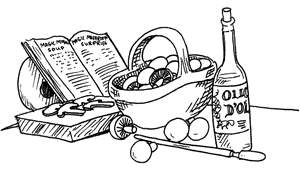STRANGE BUT TRUE- Pack animals: Dogs listen to bossman

DRAWING BY DEBORAH DERR McCLINTOCK
Q.Who are "shroomers," and how did the experience of Mr. W. begin the shroomer tale?– J. Garcia
A. After mushrooming, Mr. W. and his niece lunched on their pickings and started feeling mighty strange, says New Scientist magazine. "We became very hilarious, with the irresistible impulse to laugh and joke immoderately," he
recounted. Then they experienced vivid hallucinations. Previously mushrooms had been categorized as either edible or poisonous, but now "hallucinatory" was added, including maybe 200 out of thousands of species.
"Magic mushrooms" contain psilocybin, a psychoactive alkaloid, with effects similar to LSD though 200 times less potent. It can mimic the action of the neurotransmitter serotonin, important in perception. Generations of hippies
have tracked the story but so have scientists, such as those at the Los Angeles Biomedical Research Institute hoping to reduce the anxieties of the terminally ill, and others treating obsessive-compulsive disorder. The "Oxford English
Dictionary" has been impressed enough to add "shroomer" to its online edition. (Shroom: A Cultural History of the Magic Mushroom, by Andy Letcher)
Q. In a time of need, would you sooner help a stranger or a friend? Easy question, right? M. Theresa
A. Easy doesn't apply in the world of people on people! True, you'll sooner help friends... unless their success threatens your fragile self-esteem, say Elliot
Aronson et al. in Social Psychology. With a stranger, you're usually not involved enough to be competitive. The two threat-relevant factors are closeness to the person (why sibling rivalry occurs, especially if the two are close in age and one seems more popular or intelligent) and the personal relevance of the help task. When father and son both go into the same field, for instance, they often wind up with a more strained and distant relationship. If you help a friend do better, you can bask in reflected glory– unless the friend now outperforms you in an ego-critical area.
This is called "self-evaluation maintenance theory," or in everyday terms, unless we're saints, #1 almost always gets top consideration.
Q. This prosaic-seeming product in your medicine cabinet once helped unloose a genie, catch a criminal, and send a person flying 360 feet through the air at 30 mph. Not a bad resume. Got a guess? –A. MacGyver
A. Hydrogen peroxide, in the dark brown bottle. The genie was Jeannie of the old sitcom "I Dream of Jeannie," says Dr. Joe Schwarcz in "The Genie in the Bottle." Chemically, hydrogen peroxide decomposes to yield oxygen and water, plus a lot of heat–a reaction speeded by light, the reason for the dark bottle. Add a touch of manganese dioxide, the black powder in batteries, and poof– a cloud of white smoke! "One TV camera would focus on the smoke and another on Barbara Eden. As the smoke shot faded into the one of Jeannie, it would seem as if she were coming out of the bottle."
The stuff can also help signal the presence of blood. After a man reported his wife missing, Chicago police sprayed the house carpet with a reagant and turned off the lights: blood + hydrogen peroxide + luminol = chemiluminescence– an eerie green glow appeared. "The guy was so shaken he broke down and confessed."
On flying high, Bell Aerosystems once experimented with a rocket pack with a fuel tank of hydrogen peroxide. A fiberglass corset protected the rocketeer, who was propelled as far as 360 feet at 30 mph as the steam rushed out through a pair of ingeniously designed nozzles, says Schwarcz. "A flying genie, you might say."
Q. Can anybody explain why King Kong was in such a frightful bad temper? –D. Fossey
A. At the start of the movie classic, he's about 22 feet tall, notes University of Chicago biologist Michael LaBarbera, who made measurements off the stills. But by the time Kong climbs the Empire State Building, Fay Wray in hand, he appears to be about 50 percent bigger.
But even at 22 feet, Kong is 4-5 times the size of a typical gorilla. Scale a creature up 5 times and its weight balloons by a factor of 5 x 5 x 5, or 125 times as much– putting him close to 50 tons! This is because weight is proportional to volume, which is 3-dimensional. But bone strength depends on cross-sectional area, which increases only in 2 dimensions (5 x 5). So Kong must carry 125 times a typical gorilla's weight on bones only 25 times as strong.
At this size, he's pushing the limit of what mammalian bones will bear up, calculates anatomist Andrew Biewener.
"Is that why Kong has such a short fuse and is always rushing around, roaring and bashing things?" asks LaBarbera. "Not only does he continually run the risk of breaking his legs, undoubtedly his feet hurt."
Send STRANGE questions to brothers Bill and Rich at [email protected]